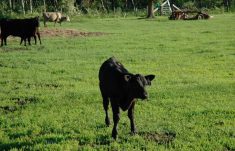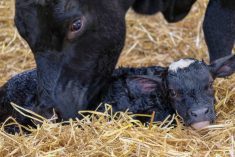Dave Longshore doesn’t take any shortcuts when it comes to proper nutrition for his purebred Black Angus operation in central Alberta.
It’s important to produce healthy, sound and fertile bulls that will be offered as breeding stock, and if cows and heifers aren’t fed a well-balanced ration with proper mineral supplements, that will also mean less-productive calves.
Longshore, along with wife Lynne and family members, operates BAR-E-L Angus near Stettler, about an hour east of Red Deer. He has been working primarily with consultant Tom McNeely of Bullseye for many years to make sure all animals are fed a proper well-balanced ration at all stages of the production cycle.
Read Also

Harvest wraps up and fall work begins
At the Eppich famly ranch in western Saskatchewan, the fall harvest was successful with few breakdowns, cows and calves have been sorted and a new tractor has arrived
“Bullseye has supplied all our minerals and premix for many years,” says Longshore, who was born and raised on the family farm. “We’ve always felt that we’ve been given the right advice and quality products which have helped us produce quality cattle.”
Longshore runs a herd of about 240 Black Angus cows. The herd is predominantly purebred with a few commercial animals used in an embryo transplant program. Each year they market about 65 head of breeding bulls, as well as replacement heifers along with Angus genetics.
Nutritional requirements for the sale bulls are managed quite differently than for cows and heifers. While cows and calves are out on mostly native grass pasture most of the summer and early fall they are supplied with a balanced “but pretty straightforward” mineral mix, says Longshore.
Bull calves are weaned from cows in late September and put on a feeding program. Heifer calves will remain with the cow herd until later in October. Depending on the year and the growing season, the cows will remain on pasture until late fall before moving to swath grazing in November.
Swath grazing blends
Longshore says they have tried several different cereals for swath grazing. “We really don’t have one standard blend. Some years the swath grazing is a combination of triticale and oats, and we’ve also grown triticale with barley, or a cocktail forage blend with triticale. They all seem to be very palatable and well accepted by the cows.”
The cows and bred heifers remain on the swath grazing until December before moving to a winter feeding program that includes native grass hay supplemented with barley and oat silage.
“Working with Bullseye we always have our feeds tested and balance the ration to make sure all nutritional needs are met,” says Longshore. “Particularly in that last trimester (they begin calving in January) we want to be sure the cows are doing well because that has a lot to do with the health of calves. Baby calf health depends on the cow health. If cow health is neglected, that will affect the calf.”
The bull calves being raised for breeding animals will be put on a full feed grain and silage ration that includes a properly formulated premix supplement. “It is a balancing act,” says Longshore. “We want to optimize rate of gain without the animals getting fat.”
The bull calves are fed a ration that targets a gain of about three pounds or more per day. “Our cattle are bred to provide that kind of performance,” says Longshore. “We can adjust as needed but we want a high rate of gain as well as a structural soundness. We want muscle development without the bulls getting fat. We are also looking for sound feet and legs.
“And of course they need to have fertility. You can produce some great-looking animals, but if they don’t have fertility then everything ends there.
“Bullseye has helped to develop the ration that delivers the performance we are looking for,” says Longshore.
















